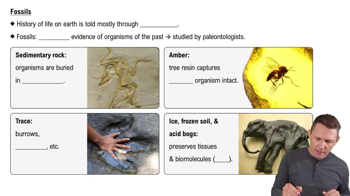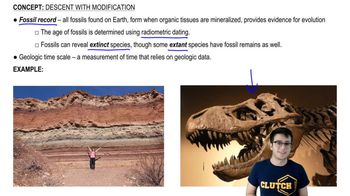You can use a 'one-snip test' to identify monophyletic groups—meaning that if you 'cut' any branch on a tree, everything that 'falls off' is a monophyletic group. Why is this valid?
Table of contents
- 1. Introduction to Biology2h 42m
- 2. Chemistry3h 40m
- 3. Water1h 26m
- 4. Biomolecules2h 23m
- 5. Cell Components2h 26m
- 6. The Membrane2h 31m
- 7. Energy and Metabolism2h 0m
- 8. Respiration2h 40m
- 9. Photosynthesis2h 49m
- 10. Cell Signaling59m
- 11. Cell Division2h 47m
- 12. Meiosis2h 0m
- 13. Mendelian Genetics4h 44m
- Introduction to Mendel's Experiments7m
- Genotype vs. Phenotype17m
- Punnett Squares13m
- Mendel's Experiments26m
- Mendel's Laws18m
- Monohybrid Crosses19m
- Test Crosses14m
- Dihybrid Crosses20m
- Punnett Square Probability26m
- Incomplete Dominance vs. Codominance20m
- Epistasis7m
- Non-Mendelian Genetics12m
- Pedigrees6m
- Autosomal Inheritance21m
- Sex-Linked Inheritance43m
- X-Inactivation9m
- 14. DNA Synthesis2h 27m
- 15. Gene Expression3h 20m
- 16. Regulation of Expression3h 31m
- Introduction to Regulation of Gene Expression13m
- Prokaryotic Gene Regulation via Operons27m
- The Lac Operon21m
- Glucose's Impact on Lac Operon25m
- The Trp Operon20m
- Review of the Lac Operon & Trp Operon11m
- Introduction to Eukaryotic Gene Regulation9m
- Eukaryotic Chromatin Modifications16m
- Eukaryotic Transcriptional Control22m
- Eukaryotic Post-Transcriptional Regulation28m
- Eukaryotic Post-Translational Regulation13m
- 17. Viruses37m
- 18. Biotechnology2h 58m
- 19. Genomics17m
- 20. Development1h 5m
- 21. Evolution3h 1m
- 22. Evolution of Populations3h 53m
- 23. Speciation1h 37m
- 24. History of Life on Earth2h 6m
- 25. Phylogeny2h 31m
- 26. Prokaryotes4h 59m
- 27. Protists1h 12m
- 28. Plants1h 22m
- 29. Fungi36m
- 30. Overview of Animals34m
- 31. Invertebrates1h 2m
- 32. Vertebrates50m
- 33. Plant Anatomy1h 3m
- 34. Vascular Plant Transport1h 2m
- 35. Soil37m
- 36. Plant Reproduction47m
- 37. Plant Sensation and Response1h 9m
- 38. Animal Form and Function1h 19m
- 39. Digestive System1h 10m
- 40. Circulatory System1h 49m
- 41. Immune System1h 12m
- 42. Osmoregulation and Excretion50m
- 43. Endocrine System1h 4m
- 44. Animal Reproduction1h 2m
- 45. Nervous System1h 55m
- 46. Sensory Systems46m
- 47. Muscle Systems23m
- 48. Ecology3h 11m
- Introduction to Ecology20m
- Biogeography14m
- Earth's Climate Patterns50m
- Introduction to Terrestrial Biomes10m
- Terrestrial Biomes: Near Equator13m
- Terrestrial Biomes: Temperate Regions10m
- Terrestrial Biomes: Northern Regions15m
- Introduction to Aquatic Biomes27m
- Freshwater Aquatic Biomes14m
- Marine Aquatic Biomes13m
- 49. Animal Behavior28m
- 50. Population Ecology3h 41m
- Introduction to Population Ecology28m
- Population Sampling Methods23m
- Life History12m
- Population Demography17m
- Factors Limiting Population Growth14m
- Introduction to Population Growth Models22m
- Linear Population Growth6m
- Exponential Population Growth29m
- Logistic Population Growth32m
- r/K Selection10m
- The Human Population22m
- 51. Community Ecology2h 46m
- Introduction to Community Ecology2m
- Introduction to Community Interactions9m
- Community Interactions: Competition (-/-)38m
- Community Interactions: Exploitation (+/-)23m
- Community Interactions: Mutualism (+/+) & Commensalism (+/0)9m
- Community Structure35m
- Community Dynamics26m
- Geographic Impact on Communities21m
- 52. Ecosystems2h 36m
- 53. Conservation Biology24m
25. Phylogeny
Phylogeny
Problem 8
Textbook Question
Use the fossil evidence shown in Figure 25.6 to determine whether flight evolved earlier in insects or in birds. Is flight an example of homology or convergent evolution? Explain.
 Verified step by step guidance
Verified step by step guidance1
Examine the timeline in the image to identify the first appearance of flight in insects and birds. The timeline is divided into geological periods and epochs, with key evolutionary events marked.
Locate the 'First winged insects' event on the timeline. It appears in the Devonian period, which is approximately 419 to 359 million years ago.
Next, find the 'First bird-like reptile' event, which is marked in the Jurassic period, approximately 201 to 145 million years ago.
Compare the two events: 'First winged insects' in the Devonian period occurred earlier than 'First bird-like reptile' in the Jurassic period, indicating that flight evolved earlier in insects than in birds.
Discuss whether flight in insects and birds is an example of homology or convergent evolution. Homology refers to traits inherited from a common ancestor, while convergent evolution refers to similar traits evolving independently in different lineages. Since insects and birds do not share a common ancestor with flight capabilities, flight is an example of convergent evolution.
 Verified video answer for a similar problem:
Verified video answer for a similar problem:This video solution was recommended by our tutors as helpful for the problem above
Video duration:
1mPlay a video:
Was this helpful?
Key Concepts
Here are the essential concepts you must grasp in order to answer the question correctly.
Fossil Evidence
Fossil evidence refers to the preserved remains or traces of organisms from the past, which provide crucial insights into the evolutionary history of species. In the context of flight evolution, analyzing fossils can help determine the timeline and anatomical features associated with the development of flight in different groups, such as insects and birds.
Recommended video:

Fossils
Homology vs. Convergent Evolution
Homology refers to traits that are similar due to shared ancestry, while convergent evolution describes the independent evolution of similar traits in different lineages due to similar environmental pressures. Understanding whether flight in insects and birds is homologous or a result of convergent evolution is essential for interpreting their evolutionary paths and adaptations.
Recommended video:
Guided course

Convergent and Divergent Evolution
Evolution of Flight
The evolution of flight involves various adaptations that allow organisms to take to the air, including changes in body structure, muscle development, and wing formation. Insects and birds represent two distinct evolutionary pathways to flight, and examining their anatomical features and fossil records can reveal the timing and nature of these adaptations.
Recommended video:

Introduction to Evolution of Populations

 7:10m
7:10mWatch next
Master Reading a Phylogenetic Tree with a bite sized video explanation from Jason
Start learningRelated Videos
Related Practice
Textbook Question
2138
views
